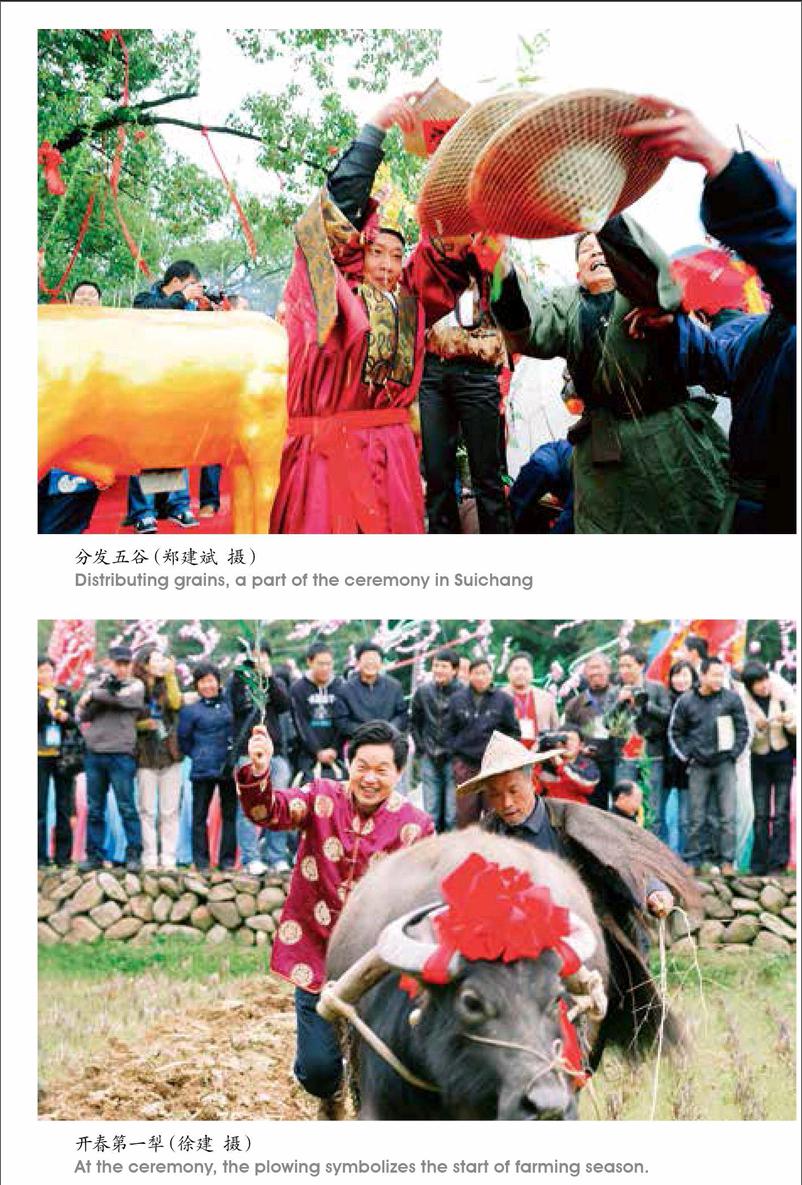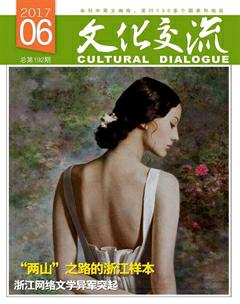班春劝农:更与春花插几枝
洪俆

人类非遗代表作“二十四节气”之二
“今日班春也不迟,瑞牛山色雨晴时。
迎门竞带春鞭去,更与春花插几枝。”
400多年前,时任遂昌县知县汤显祖不曾想到,他主政期间写下的“班春”诗,如今仍然广为颂读;他更不曾想到,2016年11月30日,中国申报的“二十四节气”被联合国教科文组织列入人类非物质文化遗产代表作名录,而遂昌县石炼镇淤溪村的“班春劝农”活动作为了“立春”习俗文化的展衍部分。
丁酉(2017)春上阴雨初霁、山色明媚的一日,笔者在遂昌县文体协会周喜玉和非遗保护中心巫苏燕的陪同下,去“班春劝农”活动所在地感受领略,探访故事。
班春,颁布春令;劝农,策励春耕。它受影响于先秦民间的“祭春”习俗,汉代时,作为官府的一项政策性活动,由地方行政长官主持;后来,或有断续。明清期间,各地大都在每年立春前后举行这一活动。浙江中西部一带、包括遂昌,往往于“立春先一日,官府迎春于东郊,祭芒神,鞭土牛,民乃兴事”(《康熙遂昌县志》)。
遂昌,民风淳厚,遗风流韵。清人诗云:“国惟民食重,俯仰望田畴。麦秀高分穗,蒿平绿刺眸。惰勤原有别,忧乐适相酬。慰劳兴东作,轻骑月一钩。”(缪之弼《春郊劝农》)乾隆年间,“班春劝农”活动演变成民众踊跃参与的群体活动,一直延续到宣统二年(1910)。
民国以来,遂昌的“祭春”有所嬗变:立春日,家家戶户自采梅花,或插于门上、引入春风,或置于花瓶、供以清香,既表示继承农耕传统,又不失耕读传家的风雅。
20世纪80年代,遂昌恢复了民间群体性“祭春”仪式,影响播扬。丁酉(2017)的遂昌“班春劝农”活动,于立春日之后的新年正月元宵节、即2月11日上演。
“在石练镇淤溪村,百姓依古礼祭拜神农、赶牛犁田,再现古代农耕景象,传承文化习俗。这场盛典,中央电视台‘新闻直播间栏目进行了现场直播。”巫苏燕提起话题依旧兴奋。
我们来到淤溪村,村口有七八株至少七八百年以上的樟树,树杆斑驳,附着片片青苔,但枝叶依旧苍翠,阴翳广大。“班春劝农”广场就傍着这些树。
立在广场四望,周围有层山、岚烟、茶园,有牛背、鹭影、水田,风景平和优美。周喜玉介绍,遂昌县的非遗项目中,一个“昆曲十番”,一个“班春劝农”,都在这个村子,先后在2008年、2011年入列国家级非遗名录。“淤溪村‘班春劝农的发端与传承要归功于汤显祖。”
明万历二十一年(1593),汤显祖由贬谪之身广东徐闻典吏“量移”浙江遂昌知县。在此五年期间,他为了实现兴农富民的理想,力行劝农务本措施:一是修建启明楼,每天准时撞钟,催人晨兴作业;二是开张相圃学堂,教学农耕农艺;三是立春时节亲临现场“班春劝农”。
周喜玉说,遂昌县素有良好的农耕文化传承。立春时节,“布谷”划过,又到一年农耕的准备期。阴阴晴晴的东郊西郊,烟烟雨雨的南乡北乡,汤显祖通过走访,选定具有典型意义的产粮田畈,制备花酒、春鞭、耒耜,精选壮牛,派衙役让各乡里组织人员,在“班春劝农”这天到现场参加观礼。“杏花轻浅讼庭闲,零雨疏风一往还。新岁班春向谁手,许卿耕破瑞牛山。”(汤显祖《初至平昌(遂昌)与苏生说耕读事》)后来,汤显祖把“班春劝农”一事写入他四梦之中“得意处”的《牡丹亭》,流芳后世。
据说,遂昌举行“班春劝农”,汤显祖为首次。此后,这一官民同乐的农耕礼仪,成为了遂昌的传统迎春文化形式。
400年前的乡村农耕景象是怎样的?今天恐怕很难为人详知。根据《牡丹亭·劝农》的描述,参考史志县志的记载,遂昌恢复了当年的盛典——
“班春劝农”那一天,广场上旗幡招展,鼓乐震天;祭坛正中巍然矗立的神农像前,香烟缭绕;代表各乡里的方阵一一就位,祭春、鞭春、开春三部曲循序展开。
礼仪开始,身穿明代服饰的迎春队伍高擎起“班春劝农”“风调雨顺”“五谷丰登”的旗帜。主祭、司仪以及春牛、供品,在鼓乐、旗幡的簇拥下,在舞蹈、茶灯、花酒等礼仪方阵的伴随中入场。司仪主持,人们向神农献上供品。主祭率领参祭的乡里代表向神农和春神行礼,接着,点高香,诵祭文,颁春令。
在亢奋的春令声中,代表人举起春鞭挥向春牛,鞭影绽处,五谷良种源源不断地溢出,被一一分发,以预示取得美好的收获,表达年丰人喜、国泰民安的愿望。婺剧、越剧、昆曲十番,众人的欢呼声飘上苍空……
我们折入粉墙黛瓦的淤溪村,这是一个有千余年历史的村子。家家门前有条石,上面摆着泥盆之类,种着花草之属,显出悠闲与优雅。是采茶的季节,村里很安静,唯有弯环流下的小溪水泠泠作响。在文化礼堂,我们和几位老人聊“班春劝农”。
“‘班春是大喜庆,大喜庆。”
“‘班春热闹,比过年热闹。”
“正月里高兴,高兴在腊月里做准备;‘班春高兴,高兴在前面一个月做排演。”
老人回忆,淤溪村和附近村子的几百名农民演员白天各忙农活,晚上饭碗一放就赶来广场排练春牛舞、茶灯舞、春鞭舞,一片锣鼓声、音乐声、欢笑声,“有文化!有文化!”
笔者想起此行之前,遂昌县非遗保护中心主任尹萍特别强调,这次参与“班春劝农”仪式演出的演员全都是周边村庄的村民,演出的节目都是自编自演,是真正接地气的传统、传承与发展。
汤显祖这位了不起的剧作家给遂昌留下了宝贵的文化遗产,“班春劝农”是特色浓郁的美丽非遗活动。活动继承了中华文明,也增添了不少民间文娱节目。
回到县城,日头正丽。遂昌县文化局局长邱根松说:“广大百姓对‘班春劝农的热情,源于对汤显祖的尊重与纪念,源于对传统农耕文化的敬畏与保护。土生土长的农民演员主导这场盛大的典礼,传递了百姓的文化自觉和文化自信,凸显了遂昌县多年来重视非遗传承保护、打响文化品牌所作的努力。”
(除署名外,本文照片由遂昌县非遗保护中心提供)
Farming Encouraging Ceremony in Suichang Marks Beginning of Spring
By Hong Xu
More than 400 years ago, Tang Xianzu wrote and other plays in Suichang, a remote rural county in the mountains of the southwest of Zhejiang. As the county magistrate from 1593 to 1598, he governed wisely while play writing was one of his pastimes. One of the big things he did in Suichang was to promote farming. According to history, Tang planned carefully. He handpicked the best venue for the ceremony. He prepared tools and cattle, whips and wine. He also sent government officials to towns and villages, urging them to send people to attend the ceremony.
The spring ceremony encouraged local residents to get ready to start the farming season. He wrote poems about the ceremony held one day before the Beginning of Spring, which usually falls on February 3 or 4 on the Gregorian calendar. One of the poems was included in the script of . That is how people of today have learned about the governors springtime farming-promoting ceremony.
The ceremony, once lost in history, has made its comeback in Yuxi Village. The village was one of the ten places across the country that still celebrate various solar terms, one hallmark of the agricultural China for thousand years. Chinas 24 solar terms were added to the World Representative List of the Intangible Cultural Heritage of Humanity in November 2016.
Agriculture promoting can be traced to early centuries before the Qin Dynasty (221-207BC). In the Han Dynasty (202BC-220AD), the spring ceremony was held to offer sacrifices to the God of Spring and mark the beginning of farming season. The ceremony became a must as stipulated by the central government and regional governors were tasked to host the ceremony. The ceremony went on and off in history. In the Ming (1368-1644) and the Qing (1644-1911), the tradition came back. In the central west of Zhejiang, the ceremony was annually held one day before the Beginning of Spring.
During the years of Emperor Qianlong of the Qing Dynasty who ruled from 1736 to 1795, the official ceremony in Suichang became more recreational. Villagers participated enthusiastically, bringing village arts into the event. In the decades following the collapse of the Qing Dynasty in 1911, the spring ceremony changed in Suichang. On the Beginning of Spring day, people picked plum blossoms. Some were placed on doors and some were placed in vases to mark the agricultural tradition.
The spring ceremony in Suichang was resumed in the 1980s. After studying the county annals written centuries ago, local scholars and government officials and folk artists successfully restored the ceremony.
The village square of Yuxi, which is more than 1,000 years old, is the venue of the ceremony. Hundreds of local residents from Yuxi and neighboring villages take part in the performance of the ceremony. Before the big day, locals work during the day and rehearse in the evening.
The ceremony consists of three parts. The first part is dedicated to the offering of sacrifices to the God of Spring and the God of Farming. The second part is the whip ceremony. Performers dance with cattle whips symbolizing the plowing before the sowing. The third part is entertainment. Village artists give shows of regional operas.
The ceremony was inscribed as a national intangible cultural heritage in 2008.

